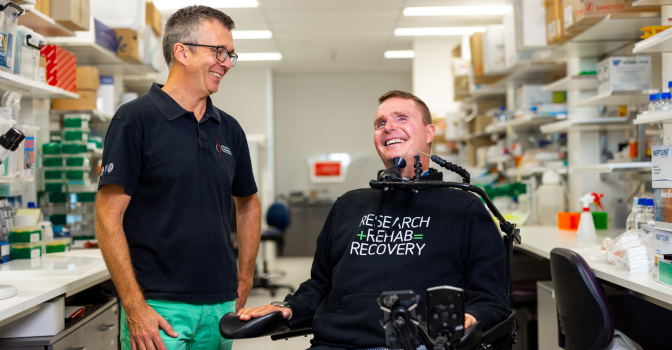Imagine if the ability to repair a spinal cord injury became a reality in the next five years. The spinal injury project at Griffith University is hoping to achieve this outcome with a proposed world-first clinical trial.
More than 20,000 Australians are affected by spinal cord injury. Every year, another 400 people experience this life-altering diagnosis.
The dedicated team at Griffith University’s Clem Jones Centre for Neurobiology and Stem Cell Research is developing a cell based transplantation therapy for people affected by spinal cord injury.
Their ground-breaking work to use cells from the patient’s own nose to help repair spinal cord damage is supported by the Perry Cross Spinal Research Foundation.
“There is light at the end of the tunnel, we are getting there. These researchers are on the cusp of something that will change the lives of people with a disability and their family and friends as well. The work they are carrying out will be life-changing for so many people,” Mr Nott said.
Drawing on research and trials conducted around the world, this project has the potential to restore motor, sensory and autonomic function (such as breathing and digestion) for people with spinal cord injury.
Using cells from the nose to repair nerve damage.
Many of the cells in our bodies die off and are replaced with new ones. But in 1990, scientists discovered that certain types of cells in the nose had a unique ability to regenerate. Professor James St. John from the Clem Jones Centre explains.
“Nerve cells in the nose that detect odours are directly exposed to the air and can die from bacteria, viruses and toxic chemicals. Every day, one to three percent of these nerve cells die. Stem cells in the nose replace and continually repair those dead cells. It is these special cells, called olfactory ensheathing cells, that help in this repair,” Professor St. John said.
Scientists wondered if these cells could help the spinal cord regenerate after spinal cord injury. The first human clinical trial led by Griffith University scientist Professor Alan Mackay-Sim showed that transplanting the cells into human spinal cords was safe. The late Professor Mackay-Sim won the 2017 Australian of the Year for his work.
Innovative nerve bridge systems.
Spinal cord injury causes a gap in the spinal cord. Nerve cells usually can’t grow across this gap due to scar tissue and the physical cavity created by the injury. That means the body can’t repair spinal cord injury itself.
The Clem Jones Centre for Neurobiology and Stem Cell Research has invented a powerful new technology called “nerve bridges”. As research fellow Dr Ronak Reshamwala explains, research shows that 3D printed nerve bridges created from the nasal cells of the person and inserted into the spinal column by a surgeon can help to bridge this gap.
“Cells migrate out of the nerve bridge and integrate with the host tissues. Once they form a bridge across the tissues, they can merge within the scar and allow the nerve cells that want to grow to come across and form a connection,” said Dr Reshamwala.
“The body can make sense of those connections and hopefully restore function. Nerve bridges can be placed right where they need to go within the injury site, increasing cell survival by a factor of 25 to 30 times.”
The rehabilitation factor.
Alongside the nerve bridge procedure, the research team found that intensive rehabilitation before and after the surgery will be critical for getting the best results.
The team has already conducted its first rehabilitation human clinical trial with five people selected from over 100 applicants. Participants started with an intense 16 week program at Gold Coast spinal rehabilitation centre Making Strides, followed by an at-home program.
Results from this trial are promising and the team is now seeking funding for a full cell therapy and rehabilitation human clinical trial. The Perry Cross Spinal Research Foundation has donated $2 million towards this human clinical trial but more is needed.
Summary of how the new technology could work.
- The patient undertakes long-term intensive exercise based therapy
- A nasal biopsy is taken from the patient to obtain olfactory cells
- Cells are purified and separated
- Construction of world-first 3D nerve bridges for cell transplantation
- Surgical transplantation into the injury site
- Long-term intensive exercise based therapy
- Functional motor, sensory and autonomic regeneration.
How to find out more or get involved.
To find out more about the Cell Transplantation and Rehabilitation human clinical trial, watch this tour led by the researchers or visit https://www.pcsrf.org.au/
The Griffith University Spinal Injury Project is also looking for volunteers with a spinal cord injury to participate in their spinal cord injury survey. If you have a spinal cord injury, live in Australia and are over 18 years of age they would appreciate your participation. The survey will take 10-15 minutes to complete and feedback will remain anonymous.
Anyone with a spinal cord injury who is interested in participating in the research or clinical trials can contact the Perry Cross Spinal Research Foundation by emailing team@pcsrf.org.au.

